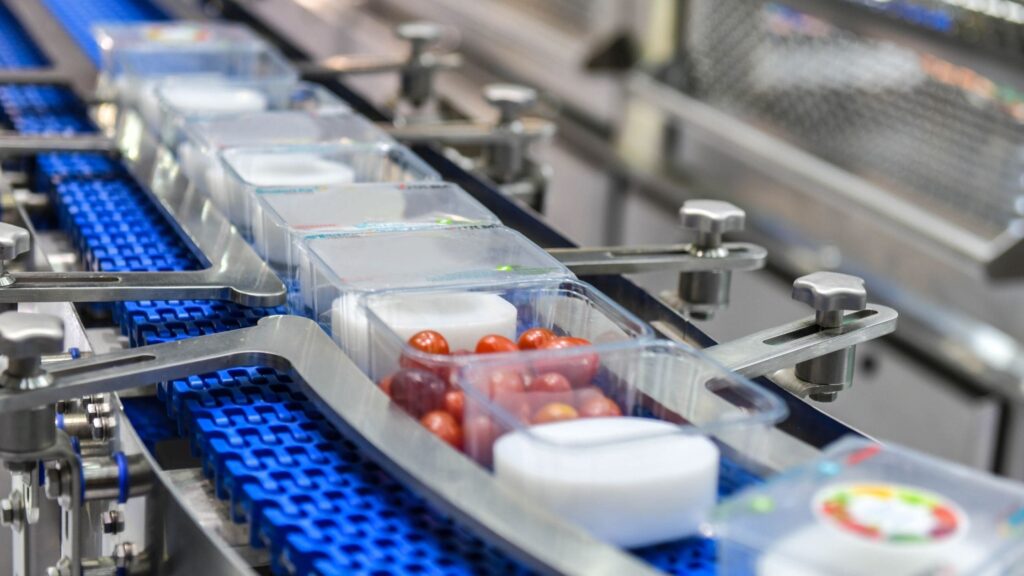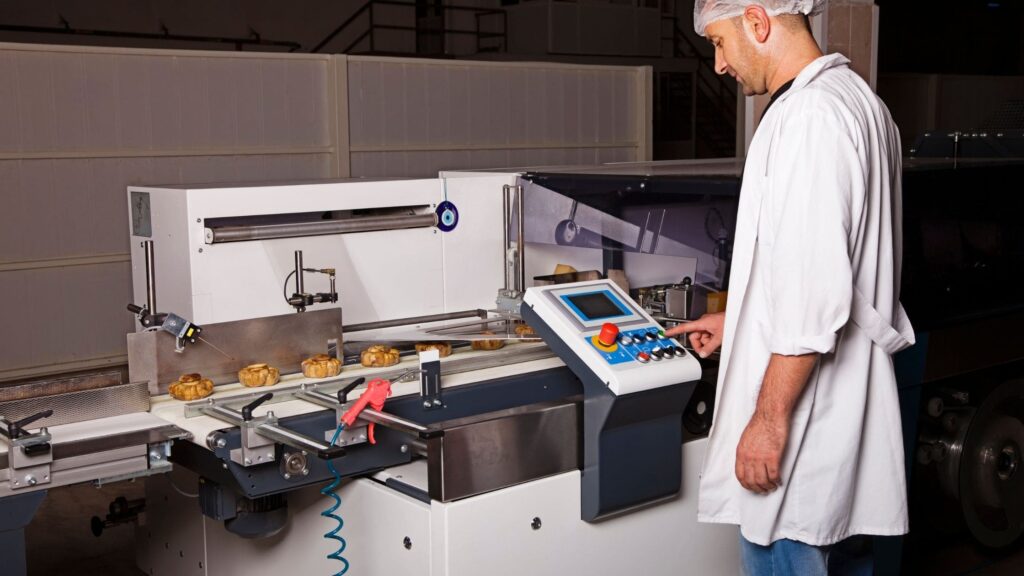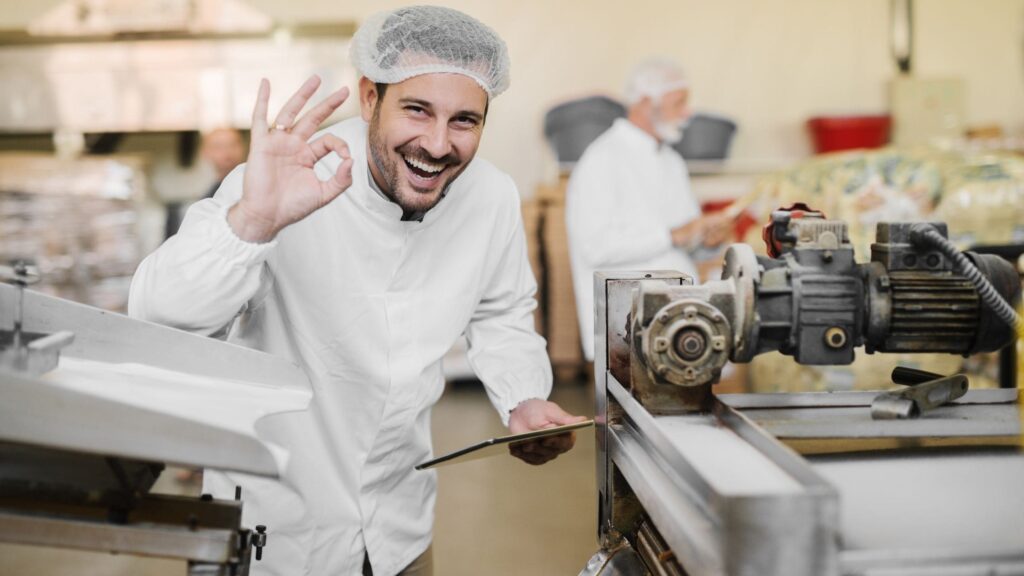What is a Pick and Place Robot and How Does it Work?

The food processing and packaging industry is growing at a rapid pace. To meet the growing demands and required efficiency, manufacturers are using robotics to achieve tasks that would otherwise require dedicated manual labor.
Pick and place robots are one of the most commonly utilized automation machines in the food packaging workspace.
In this article, you will learn all about pick and place robots, what they are, and even the different applications and types of these robots out there. Let us begin our study right away.
What is Pick and Place Robot?
Pick and place robots enable companies to use automated solutions for lifting objects from one location and placing them at other locations.
Simple tasks such as lifting objects or moving them do not require a lot of thought processes. Therefore, using human workers on these tasks can be wasteful, as the workforce can be used for other tasks that require higher mental abilities.
These repetitive tasks are handled by pick and place robots. These robots are often equipped with sensors and vision systems to lift objects from moving conveyor belt.
Who invented Pick and Place Robots?
The pick and place robots used for monotonous tasks in the food packaging industry nowadays are based on the Delta robots. Delta robots were designed in the early 1980s by a research team led by Professor Reymond Clavel at EPFL, Switzerland.
The mass-scale production of packaging pick and place robots started in 1987 when a Swiss company called Demaurex purchased the license to create these robots.
In 1999, FlexPicker delta robot was launched by ABB Flexible Automation, which became a major game-changer in the field.
The field of pick and place robots is still developing, with researchers optimizing these robots for picking even smaller items for computer processors, or for higher speed repetitive tasks and precision.
How do Pick and Place Robots Work?

These robots are typically mounted on a stable stand, and have a long arm that can reach their entire area of operation. The end of arm attachment is specialized to the type of objects the robot intends to move.
These robots can transfer items from a stationary surface to a stationary surface, stationary to a moving surface, moving to a stationary surface, and moving to a moving surface (such as between two conveyor belts).
How many axes do a traditional pick and place robot motion can occur?
Simple pick and place robots that lift items and place them at other locations have a 5-axis robotic arm. However, there are also 6-axis robotic arms in use that can twist the items to rotate their orientation.
What are the different parts of a pick and place robot?
A pick and place robot has several dedicated parts, such as:
Robot Arm tool: A robotic arm, also known as a manipulator, is the extension of the robot by using cylindrical or spherical parts. links, and joints.
End Effector: The end effector is the accessory at the end of the robotic arm, that does the required job such as gripping objects. The end effectors can be designed to perform different functionalities based on requirements.
Actuators: Actuators create the motion in the robotic arm and end effectors. The linear actuators are basically any type of motor, such as servo motor, stepper motor, or hydraulic cylinder.
Sensors: You can think of sensors as the eyes of the robots. The sensors do the tasks like identifying the position of the object.
Controllers: Controllers synchronize and control the movement of different actuators of a robot, thereby being the brain behind the smooth robotic operation.
What are the Different Types of Pick and Place Robots?

Cartesian Robots:
Cartesian robots move items in multiple planes, using X, Y, and Z coordinates (known as cartesian coordinates).
Fast Pick Robots:
Fast pick robots pick items at a very high speed, which is why there are used in high volume applications. These robots are capable of moving about 300 items per hour.
Robotic Arms:
Robotic arms are the simplest and most common type of pick and place robots. As described earlier, they are used as 5-axis and 6-axis robotic arm. 6-axis robotic arm works similar to cartesian robots but has lower positioning accuracy compared to delta robots.
Delta Robots:
Delta robots can pick items and place them in predefined assembly patterns or groups. These robots can be equipped with sensors or vision systems to select items based on different colors or sizes.
Collaborative Robots (Cobot):
Collaborative robots are named so because they work in collaboration with humans. Their purpose is to guide humans to the picking location or the desired location. These robots can create an optimal route to minimize transporting time.
What are the Advantages of a Pick and Place Robot?

Speed:
The speed of operation is one of the major reasons in favor of pick and place robots. These machines can lift a lot of objects at the same time that it would take a human worker to lift one object.
Productivity:
Due to a higher speed of operation, a pick and place robot has higher productivity than human counterpart. This is why modern manufacturing environments are able to roll out a higher number of products, to increase production rates.
Uninterrupted Production:
Human workers require breaks, which can lead to interruptions in the production line. Interruptions also occur during the change of shift of workers. However, robots do not require breaks and can work all day and night.
Consistency:
Human labor always brings in the factor of human error. However, a pick and place robot will work on exact mathematical principles, so there are no errors and the end result is a consistent operation.
Safety:
Lifting objects involves the risk factor of the object falling down on human workers and causing injuries. However, robots have no such risk, leading to higher safety in the workplace.
Return on Investment:
Pick and place robots enables companies to minimize running costs by incurring a small initial investment. There are no salaries and no benefits to pay. This results in a higher return on investment in the manufacturing processes.
Throughput:
Pick and place robots result in a higher throughput as they can move a lot of objects in a given time. As mentioned earlier, fast pick robots are capable of moving items at the rate of 300 skus per hour.
Applications of Pick and Place Robots
Even as food packaging industrial robots, pick and place robots serve several different applications. These applications include:
Assembly Applications:
In assembly processes, pick and place robots can gather multiple parts from multiple locations, and assemble them at one place. Complex work in electronic environments is done using these types of pick and place robots.
Packaging Applications:
As a packaging utility, pick and place robot grab the food items and place them in a packaging container. To load the items into a packaging container, they can even be picked from a conveyor belt.
Bin Picking Applications:
In bin picking applications, pick and place robots are capable of picking up a particular item from a bin. These pick and place robots have advanced vision systems that enable them to accurately identify the required item, an application required in bin picking.
Inspection and Quality Controls:
Inspection and quality control pick and place robots identify each item to find out if it meets the quality control protocol of the manufacturer. If the items fail, the robot can remove the item from the production line.
Part Sorting:
Part sorting robots can sort different objects based on their shape or the information provided on the object itself. These can be used to segregate parcels or for similar applications.
Medical Applications:
Pick and place robots are also finding their applications in the medical sector. They not only help in sorting the medical inventory but can even assist in complex surgeries.
Industries That Use Pick and Place Robots

Packaging:
Packaging is one of the most common types of applications of pick and place robots. From food packaging in a packaging container to palletizing robots, pick and place robots have a vast use in food processing industry.
Delivery:
Pick and place robots have found their application as delivery robots as well in several high-tech environments around the world.
Research:
These robots are also used for research purposes when handling highly sensitive elements and compounds in a scientific environment.
Electronics:
Pick and place robots place incoming components on circuit boards of electronics like phones, TV, computers, etc. are brought and assembled together by pick and place robots for fast assembly processes.
Palletizing robots:
Pick and place robots are used in some form in almost every industry as palletizing robots, for placing items one on top of another to make stacks (called Pallets) of items.
How to Choose the Right Pick and Place Robots for Your Business?

Axes:
The number of axes determines the directions in which the robot is capable of moving. A five-axis robot can pick and place an object to any location within the same plane, while a six-axis robot can transfer objects to different planes as well. Additional axes can create twisting and turning motions for different orientation of the object.
Reach:
The reach is the entire work envelope that the robot can reach. The robotic work envelope will be defined by the spread of your workplace. A larger, spread out workspace will require a robot with a larger reach. For a smaller workspace, a smaller reach is sufficient.
Speed:
For high volume applications, you will require a high speed pick and place robot. If your volume requirement is not that high, you speed of movement is something you can compromise.
Repeatability:
Repeatability is the robot’s ability to pick and place items to the exact particular location. High repeatability means better positioning accuracy, and is a desired quality for a smoother operation.
Best Pick and Place Robots
If you want a pick and place robot that does well in all the factors we defined above, you might want to check out PwrPack’s range of pick and place robots.
These robots are industry-leading machines that not only serve the purpose, but end up exceeding your expectations due to their flawless designs and high-build quality.
These robots come with a complimentary optimized software that leads to a superfast speed of operation. They are ideal for any food packaging application, be it high speed biscuit packing, pet food, bakery goods, or any other applications.
How Much Do Pick and Place Robots Cost?
Pick and place robots are not just one robotic machine, but a properly integrated system consisting of conveyor belt, advanced vision systems, and more. The entire setup is cheaper than you might spend on labor, and costs somewhere between $40,000 to $50,000.
Simple pick and place robots that do not require high-tech facilities such as advanced vision technologies can come at just a few thousand dollars.
If you compare these numbers with what you spend on the human workforce and related expenses, you will find that the human counterpart costs twice or thrice as much, making pick and place robots a significantly cheaper and more efficient investment.
Conclusion
In this day and age where the manufacturing process happens on a production line to meet peak demand periods, handpicking items is no longer an option.
Any area that slows up production is just another bottleneck in the manufacturing process.
This is why, pick and place robots are not just an option but a necessity in this environment. This is especially true for the food packaging industry, where there are added factors at play such as contamination by humans or preserving food integrity.
PwrPack’s range of high-speed pick and place robots enables companies to meet the growing demand, with the perfect capability of high-end automation.
Frequently Asked Questions
[/vc_column_text]
Does pick and place robot have rotary motion?
Yes, pick and place robots can have rotational movements as well as linear motions. It all depends on the number of axes that your pick and place robots have.
How accurate is the pick and place robots?
The accuracy of pick and place robots can vary from particular model to model. PwrPack’s pick and place robots are one of the highest accurate machines out there, with very high repeatability.
What is the degree of freedom of a pick and place robot?
The degree of freedom (DOF) is another term for the axes of a pick and place robot. It defines the number of directions in which a robotic arm can move, be it linear directions or rotational directions.







